Five Key Lessons for Mastery Learning Startup
CompetencyWorks Blog

This post originally appeared at Springpoint Schools on January 5, 2016.
As I see it, the biggest challenge we face in American public schools today is this: we’ve got an antiquated factory-based school model, and a workforce that has proven particularly effective in implementation. Let’s face it: most of us were taught this way as students, and most of us were trained this way as teachers. I among.
For the last several years, I have had the opportunity to serve as the Mastery Learning Specialist at the School District of Philadelphia, a position made possible by the Carnegie Corporation’s vanguard school design grant, Opportunity by Design. The grant afforded us as a design team a full year to engage in deep research, scan the field, visit exemplary school sites, talk with stakeholders, design, get feedback from experts, reflect, and iterate on our work.
The experience was transformative. Out of this collaborative design experience have emerged multiple open admission, competency-based schools in Philadelphia, and an open-source competency model, designed and developed as a collaboration between the School District of Philadelphia and nonprofit partner, Building 21. We call it the Learning What Matters Competency Model. The LWM Competency Model has been described by experts as “a major contribution to the field,” and “one of the strongest, personalized, competency-based models in conception.” I share that not to boast, but to say, we took the work very seriously, we were set up for success by the resources invested in the project, and we are now keen to explore opportunities to share the model broadly and invite others to improve, and build upon, the work.
I have come to believe that if you are serious about innovation in education generally, and about transforming outcomes for historically underserved youth specifically, you’ve got to study up on competency-based education (CBE). In every way, CBE challenges the dominant pedagogical model of our American public schools and the assumptions on which it is based. It embodies the principles that I believe must guide and ground the work of redesigning our public schools.
Competency-based education is, interestingly, both ancient and nascent. It is the core of our oldest apprenticeship models that span history and pre-date our formal schooling institutions, yet at the same time, it is an emergent and rapidly growing strand within our current education landscape. Schools and school networks are leading the way in practice. Funders are prioritizing “mastery-based” or competency-based (my preferred term) learning models. Many states are making significant shifts in policy in order to provide the flexibilities needed, such as removing seat-time mandates, rethinking the Carnegie credit as the time-based unit of learning, and exploring flexible promotion, crediting, and graduation pathways and policies. In other words, this is happening – and it’s a powerful and important tide of change in our time.
Drawing from my experiences and observations over the last several years supporting three new competency-based school startups in one of the largest, poorest urban school districts in the United States, I submit to you five key lessons for mastery learning startup:
- Understand the key shifts.
- Define mastery, then build your policies around it.
- Apply the 80/20 rule.
- Stage the work; nail instruction and stakeholder communication.
- Hire with care, and for a specific set of skills and dispositions.
1. Understand the key shifts.
I cannot emphasize enough the importance of dedicating time to exploring together as a team, and reaching a shared conceptual understanding of, the key shifts of competency-based education. Specifically, what do these principles mean for our practice? This is the most important question, and it merits much deliberation as a team. The shifts are significant, and they can be difficult to navigate because they not only create new demands on teacher practice and performance, they require a different way of thinking about teaching and learning that diverges from today’s K-12 norms.
So what are these key shifts in practice called for by CBE? The following table was constructed as a synthesis of the most significant shifts of CBE.
Understanding the Key Shifts:
The “From-Tos” of Competency-based Education

I’ve heard it summed up before quite elegantly: In contrast to traditional schools, in which “time is the constant, and learning is the variable,” in competency-based learning models, “learning is the constant, and time is the variable.”
So where to start? Let me share an open-source gold mine of resources for understanding competency-based learning more deeply, and for supporting your design and implementation efforts. Check out the “Mastery” page of reDesign’s recently published Design Lab. This is the culmination of a knowledge-building projected funded by the Carnegie Corporation of New York and completed in partnership with Springpoint Schools, all aimed at “making mastery accessible” to educators across the field. It is stellar, and it is free!
You can also check out our ever-evolving LWM website to see a concrete competency education model, steal our competencies and rubrics (go for it!), or glance at our student handbook that explains the model in family-friendly language and visuals: www.competencytoolkit.org.
One of the reasons this early conceptual understanding is key among school leadership and faculty is that, in a new school model, you’ve got a critical first year to build buy-in among your stakeholders. If your teachers are not equipped with the tools for explaining and reinforcing the model for students and families, it’s likely everyone is going to attempt it in their own way. I’ve witnessed the flurry of confusion that follows. A few suggestions for getting ahead of this challenge:
- Create a mini rolodex of helpful analogies to draw from (e.g., Driver’s License comparison for performance-based assessment; basketball scrimmage vs. game time for formative vs. summative, and so forth);
- Develop a clearly defined lexicon that everyone is using purposefully (e.g., Glossary of Terms)
- Define a consistent set of school-wide practices, norms, and visualizations to help students understand how learning happens in the new model (e.g., Check out Matchbook’s GPS Learning Cycle – beautiful!)
There is an inherent tension in hiring teachers for school models that don’t yet exist. If you can take everyone through a shared learning cycle of the key shifts in competency-based education and the implications they’ll have for your team, you will be making a critical investment in your first year of implementation.
2. Define mastery, then build your policies around it.
If you scan the field, you’ll notice that mastery means many different things to different folks. Some define mastery as “80%!” Some define mastery as “Advanced!” Others use the term mastery, but have not yet defined it. It is important to be clear, thoughtful, and I would argue, quantitative, when you define mastery. You’ll want a consistent set of tools (rubrics, a rating system, scoring rules, and calibration protocols) for measuring it fairly and consistently, too. The tricky part is that you may not be able to arrive at your definition of mastery until you’ve walked through a number of prerequisite steps.
Are you up for a game of twenty questions? I share the following question set as an exercise in bringing clarity and specificity to your definition of mastery.
Defining Mastery
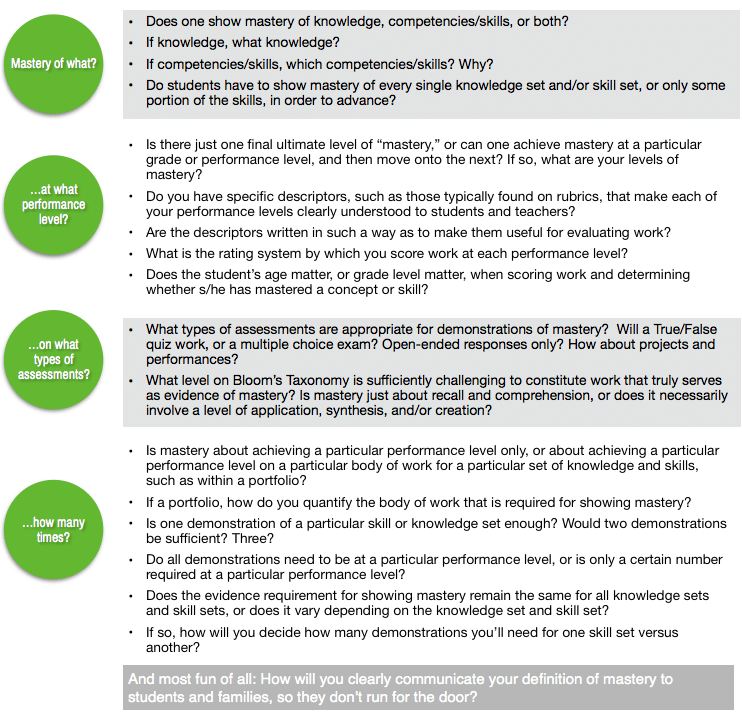
In our LWM model, we let the five key tenets of competency-based education and our reflections on work and life in the world be our guide to answering each of these questions. We spent months researching, reflecting, drafting, and revising before we finally landed on our definition of mastery.
A quick snapshot of our steps:

First, we designed competencies based on nationally valued standard sets (Common Core, Next Generation Science, C3 Framework for Social Studies, and others) and structured them simply as groupings of related skills. We looked at every example set of competencies we could find, and largely based our design work on that of Great Schools Partnership graduation standards. We then drew on our team’s expertise, and that of the advisors we engaged, to make decisions about adaptation.
We organized our competencies by subject area to keep it simple for stakeholders, even though most of our competencies are interdisciplinary. For example, we categorized “Argumentative Writing” under ELA, and “Data Analysis” under Science, even though in practice we expect to see interdisciplinary tasks and projects across learning spaces. Not only did this simplify our message to stakeholders, it also made mapping competencies to traditional courses easy, which we had to do in order to be in compliance with district and state policy.

Next, we built rubrics (we call “continua”) for every one of our thirty-four academic and efficacy competencies, which are essentially student-facing learning progressions. Note that we built continua for competencies, rather than for performance tasks or assignments. This was a philosophical as well as a practical decision: we wanted our competencies to anchor every learning activity and assessment, and we also wanted teachers to be creative when designing tasks without having the endless burden of designing task-specific rubrics.

We decided to make our performance levels numerically match grade levels, and then decided that our performance levels would also serve as our rating system, such that if you earned a “9” on the continuum, this meant you were performing at a 9th grade level. We preserved grade levels (and matched performance levels) to make this familiar and simple for stakeholders: “If your grade level matches your performance level, you’re on track!”
Our rubric construction was guided by the language of grade level standards as well as every exemplar, open-source rubric we could get our hands on. We refused the typical deficit language of rubrics (e.g., “what’s missing”), and instead, crafted performance descriptors using developmental, student-facing language that kids could understand, and that both teachers and students could use on a daily basis. Check out Asia Society’s work on Educating for Global Competence for another example of a similar appreciative approach. In essence, our rubrics were designed to serve as student-friendly learning progressions that would guide instruction, evaluation of learning (down to the skill level), feedback cycles, and revision of work.

Once we had our competencies, our rubrics, and our rating system, then we set our evidence requirements and finally defined mastery. In principle, mastery means demonstrating proficiency of skills in multiple ways and in multiple contexts. In practice, mastery means completing a quantified body of work at an overall performance level that matches a numerical threshold set for mastery at each grade/performance level.
For example, to show mastery within a 9th grade course, you need to demonstrate an average performance of “8.5” overall (an average of skill ratings) on all course competencies. The average is always a “best-of” for the evidence requirement. An illustration: if there are two required demonstrations of the competency, Lead a Scientific Investigation, and you submit four tasks over the term of the course, then only your top two are calculated as part of your overall performance so you’re not penalized for what is ultimately your demonstrations of growth. It’s important to note that, in our model, performance tasks are the only work products that contribute to a student’s mastery portfolio. Everything else is simply in service of this mastery portfolio.
Here is an example of one of our science competencies, which is made up of six measurable skills. Based on ratings for the two required tasks, this 9th grade student has exceeded the minimum threshold of 8.5 for showing mastery at a 9th grade level (on this particular competency).
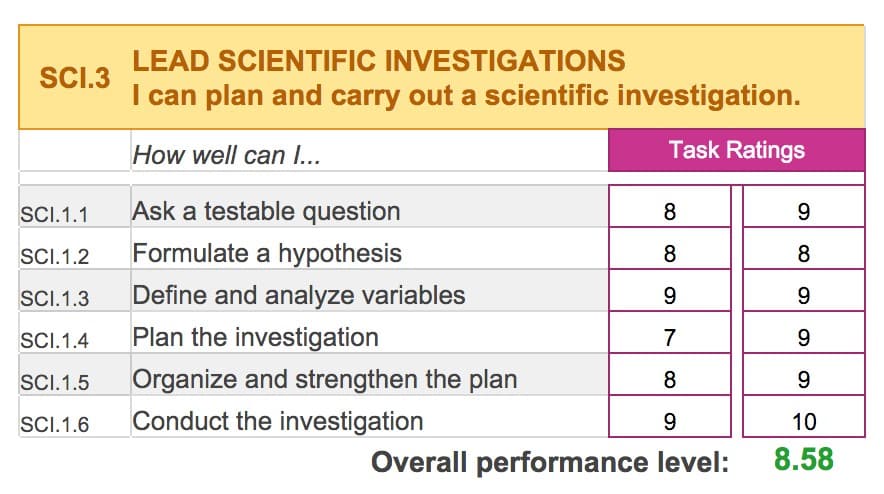
By redefining learning in terms of specific, measurable skills — rather than in terms of courses and units of time — schools are positioned to undergo a radical re-orientation toward outcomes. Imagine what is possible in the way of personalizing student learning! Nobody gets stuck in a course (or retaking a course without consideration of what was actually learned and what wasn’t). Every learning space, every learning moment, is purposefully connected to a clearly defined outcome. Schools can reclaim a powerful value proposition: we’ll help you discover the joy of building useful skills, and we’ll help you prepare for life after school.
Here is an excerpt of the continuum that matches the science competency referenced above, for the first skill “Ask a testable question:”
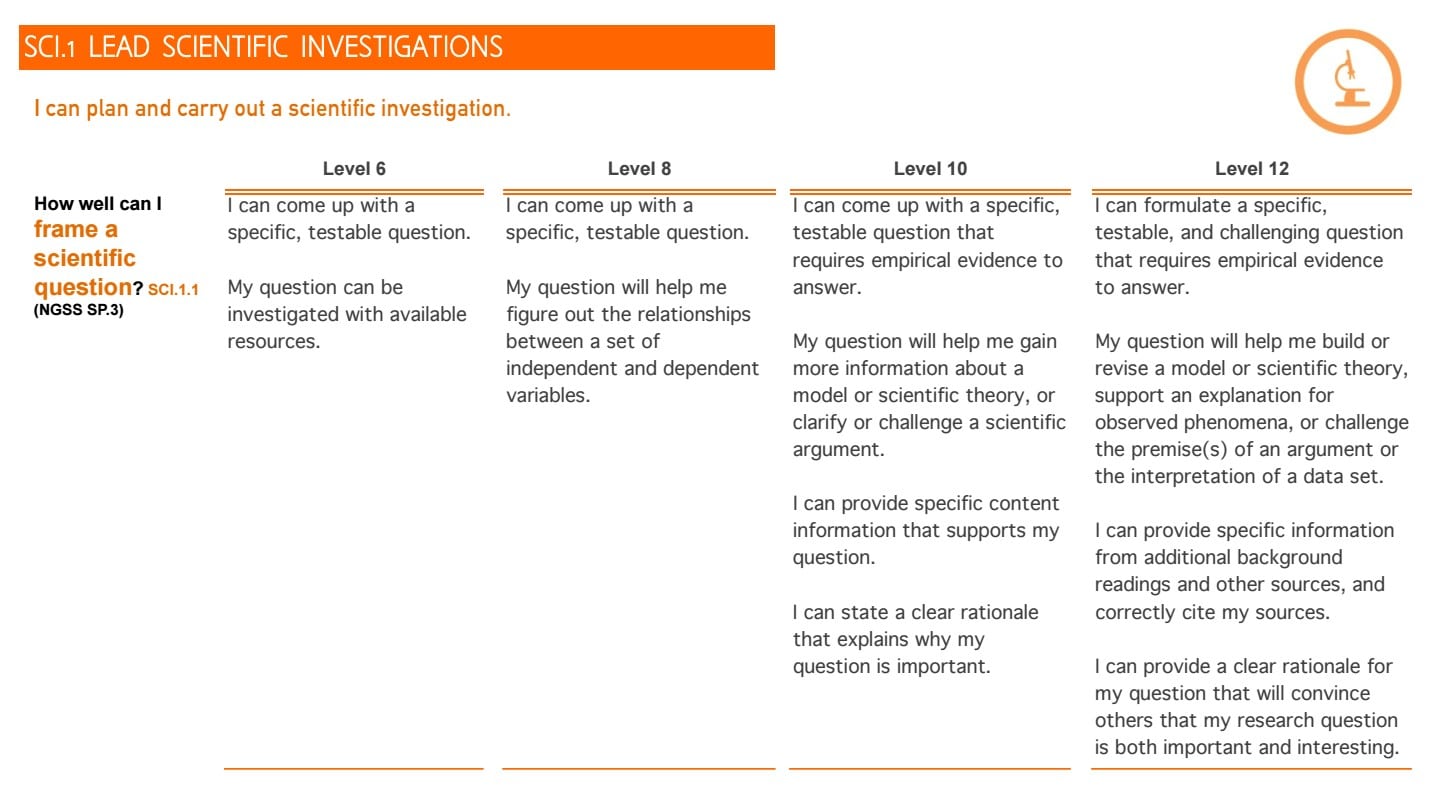
Finally, we built a conversion chart by which we could convert students’ overall course performance levels to traditional course grades. To make this work within our school district, we mapped competencies to traditional courses. We also flipped Honors credit on its head: instead of students being rostered to an Honors course based on past performance (which is arguably subject to bias), we give students the opportunity to earn Honors credit by their performance on their portfolio of work. For example, as a ninth grade student taking a 9th grade course, if you earn an overall performance on course competencies of “9.5,” you have earned Honors credit and thus a higher weighted GPA. Unfortunately, the state of Pennsylvania penalizes schools who don’t have a certain number of students rostered to Honors at the beginning of the year — an example of a state policy that needs to be re-examined to support this approach.
Mastery Grade Conversion Chart
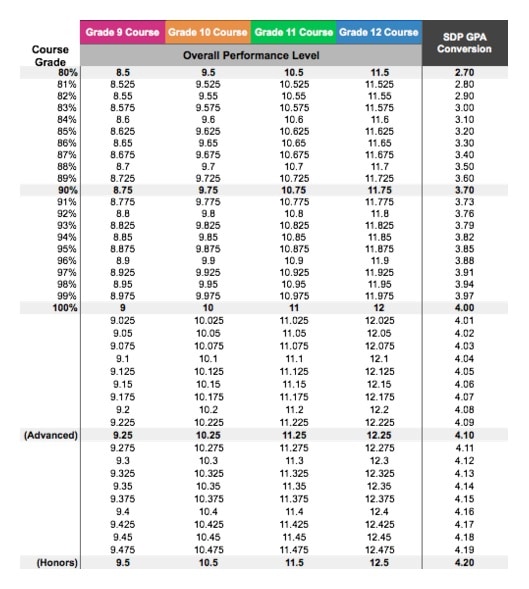
You might ask, how did you set the evidence requirement for the portfolio? Why did you decide that two argumentative essays were required for 9th grade mastery, but let’s say, four argumentative essays are required for 12th grade mastery? We love this question!
We looked at a study conducted by reDesign, in which they scanned the syllabi of freshman level courses in higher ed institutions across the US – from some of the most competitive, to some of the most open. They found a remarkably similar set of tasks that first-year college students are expected to complete. They also found a remarkably similar workload. You can check out their findings here. We used this work as our benchmark for “college readiness,” and then attempted to scaffold the workload backward.
A word to the wise: watch out for tech platforms that have already defined mastery for you! For example, we looked at several products that claimed to be “mastery-based gradebooks.” However, they did not allow you to customize your competencies, or more important, customize the evidence requirement for a particular skillset. For them, it was one-and-done: if you achieved 80% on a standard, then yay! Mastery! Meh.
We couldn’t find anything that allowed for the level of customization we needed. We opted to build our own open source competency-based gradebook for the LWM model, spearheaded by the nonprofit, Building 21. I won’t go into details here, but do reach out to [email protected] if you’d like to learn more about the open source system.
Here’s a screenshot of the teacher view, with competencies on the Y axis and students on the X axis. Percentages represent progress on evidence requirements, by competency. One really exciting feature? None of this data is confined to a course. It’s a true, meta view of students’ performance and progress on competencies, which they can build and demonstrate in any learning space. All the data feeds into the same profile, an infrastructure that creates exciting opportunities for rethinking learning spaces and interdisciplinary learning experiences.
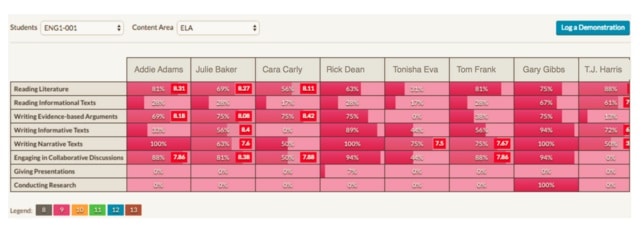
Back to the point, here: it’s important to define mastery upfront for your stakeholders. Even if you only have a working definition to begin with, put it out there in writing and visuals. I’ve seen the end-of-year confusion and frustration that can be caused when these expectations for student performance are not clear from the beginning. It simply isn’t fair students or parents, particularly when crediting decisions hinge upon your definition of mastery.
One other important point for consideration: decouple your conceptions of mastery and crediting. These are two very separate things. Mastery is about demonstrating skills at particular performance levels. Crediting, in our current Carnegie-unit world, is about assigning value to time spent in courses toward an ill-defined “graduation-ready” outcome. So don’t jump to the conclusion that mastery is the requirement for crediting without thinking it through, and making sure that is your intention. In our LWM model, we offer students two ways to earn credit: by demonstrating mastery, or by demonstrating growth. For us, this is as much about student motivation as it is about fairness and pragmatism. Check it out:
Crediting by Growth Chart
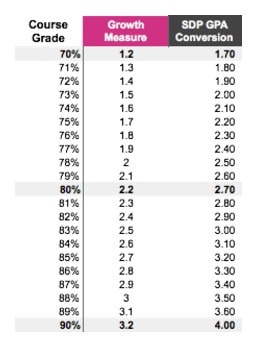
A ninth grader, for example, who completes the portfolio of work required at an overall performance level of 8.5 or higher has shown mastery at the 9th grade level. Great! But what about the student who showed up at school performing at a 4th grade level in reading and math?
There is no evidence basis out there to suggest that five years of growth in a single year is feasible. So let me turn the question: if this student were to demonstrate 1.5 or 2 years of growth within a year’s time for ELAcompetencies, would you withhold credit? Remember the stakes, here. What, in your model, is credit attainment really all about?
We think this is an amazing opportunity to personalize learning and to personalize the graduation pathway. What if upon entry, each student’s baseline performance were determined, and a target timeframe were established for the total number of years the student plans to be in high school (ranging from 3-5)? And then what if we calculated a personalized, year-to-year growth goal necessary for achieving the graduation target — and then made that goal the threshold for earning credit? Food for thought.
3. Apply the 80/20 rule.
Ever heard of the 80/20 rule? It’s called the Pareto principle and states that, for many events, roughly 80% of the effects come from 20% of the causes. I like to think of it this way: focus your greatest effort on the 20% of the work that is going to generate 80% of the results. I’m going to show you a graphic created by reDesign, and then explain why this matters.
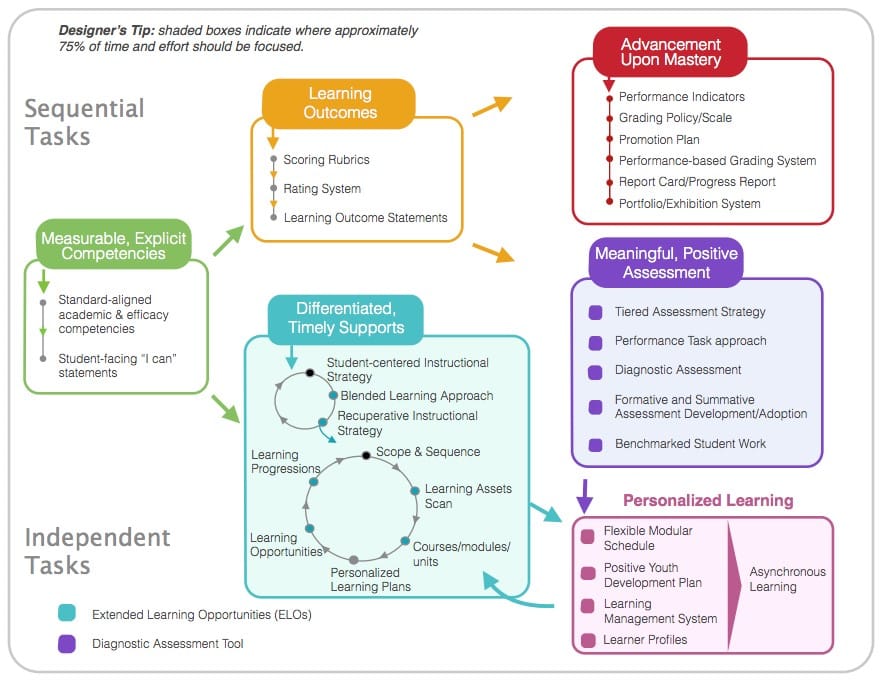
The graphic above organizes each of the key elements of a Mastery Learning System around the five tenets of competency-based learning. In other words, how do you bring these five tenets of competency-based learning to life in an actualized model? These are the must-have pieces, and a recommendation for the sequence in which to develop them. For example, before you start building rubrics or creating assessments, you need to have your competencies in place, as they define the learning aims and goals to be evaluated.
See that Designer’s Tip up in the left-hand corner? That designer’s tip should be in 200-size font and bright red letters across the page. It states: “The Shaded boxes indicate where approximately 75% of time and effort should be focused.” So guess where our design team spent about 80% of our time during our design year?
Right. Not those boxes. In fact, exactly all of the other ones.
OK, here’s the lesson learned: when designing your Mastery Learning System – or competency model, as we like to call it – do not repeat our mistake and spend all of your time designing competencies, rubrics, and grading and assessment policies! Don’t do it. We did this because we felt we had to — we struggled to find the open source resources from the field that we believed were essential to the model. The field is in a different place now, and we hope our work has contributed to that in some way, as everything we’ve developed is and will remain 100% open source.
The graphic above comes right from reDesign’s open-source Design Lab, and when this time-effort recommendation was first pointed out to me, I about fell out of my chair.
Let me tell you why this was such a big pain point: because our teachers began the year without high-quality, competency-aligned learning resources, like units of study with engaging and relevant learning activities, formative assessments, leveled text selections, competency-aligned performance tasks, and so forth. You just can’t get anywhere without great curriculum — but very little out there was aligned to our competencies. Put another way, very little out there stood up to the rigor called for by the national, college-ready standard sets on which we based our academic competencies.
Curriculum design and development is probably the most time-consuming teacher responsibility. This is why I love Educurious. They’ve built stellar student-facing (this is key) units of study that are problem-based (read: highly engaging!) and that culminate in fun and truly rigorous performance tasks. Not all of our teachers went for it. Candidly, some felt they could do better. But then, they didn’t, because of course once the year kicks off, who really has time for this kind of intensive design work?
The take-away: adopt whatever you can in the way of your competency model, and during your design year, focus heavily on building, or sourcing and adapting, stellar student-facing, competency-based units of study, and the performance tasks they build toward. If nothing else, do this.
Right now, go download this free Roadmap that will guide you through each step of the way in building your competency model. You can also check out reDesign’s content-agnostic college-ready performance tasks. They are teacher-facing, not student-facing unfortunately, but they offer a highly structured, step-by-step guide to implementing high-quality tasks. Stanford’s Center for Assessment, Learning, and Equity also has done very deep thinking and work in the arena of performance-based assessment, and they are certainly worth checking out.
4. Stage the work; nail instruction and stakeholder communication.
You cannot do it all. Trust me on this, because we tried. And we learned. You cannot do it all.
If you can accomplish only three design-related objectives in your months preceding school opening apart from unit development, let it be, in this order:
- Pedagogical model
- Stakeholder communication plan (including reporting templates, conferencing protocols, and communication infrastructure)
- Three-year roadmap to full implementation.
I use the term pedagogical model, rather than instructional model, because pedagogy combines both theory and practice, and I don’t think we should define practice without being transparent about the theory on which our practice is based. It’s always based on something.
Just because you have competencies and rubrics does not mean you have a pedagogical model. Just because you have a competency-based grading and assessment policy does not mean you have a pedagogical model. Just because you are 1:1 and have decided on your LMS does not mean that you have a pedagogical model.
You need a pedagogical model, people.
Why prioritize the pedagogical model? Because it’s essential to be clear with stakeholders – particularly your teaching team – about how this is all supposed to work. As Steve Jobs put it, “Design is not just what it looks and feels like. Design is how it works.” In each of our three new school startups in Philadelphia, I believe that each new school leader would say something along the lines of, “this wasn’t clear enough for my team when we started, and everyone struggled greatly as a result.” Derived from my observations and reflections on our startup year, here is a proposed set of key components for a pedagogical model, followed by several essential questions to explore around each of the eight key components (feel free to poke holes in this construct):
Eight Elements of an Instructional Model

- What’s your (research-based) theory of learning? Consider breaking this out into a flow chart, and make sure everyone on your team gets it and is on board with it. What do you believe must happen in order for students to successfully achieve proficiency/mastery for a newly introduced set of skills, knowledge, and/or dispositions? Here is a strong research-based example: Framework for Effective Instruction.
- What are the learning goals all students are working toward? These are the skill sets (competencies), knowledge sets, and habits of work that you envision all students achieving. They need to be clear, measurable, and accessible to your stakeholders. Check out our LWM competency sets as an example.
- What competency-aligned curricula will you use to achieve the aforementioned learning goals, and in what format will they be made available to students? By curricula, I mean the student-facing, (preferably) problem-based units of study that purposefully sequence student-facing learning assets, learning activities and processes, formative and summative assessments. I mentioned Educurious’s project-based courses — the strongest curricular exemplars I’ve seen in the field. Note that our LWM competencies are about skillsets, and do not explicitly include content knowledge (e.g., the water cycle, the War of 1812), so these content standards need to be clearly defined for teachers based on the subject areas they teach. One way to think about this is that the content serves as the context in which competencies are developed and demonstrated. Example: as I study the effect of light exposure on the process of photosynthesis in plants, I have the opportunity to practice and show evidence of my ability to Lead a Scientific Investigation (the competency).
- What is your school’s primary learning facilitation model, and the norms and expectations that guide it?This will tie directly into your theory of learning. In short, you are defining the scope of teacher activities that must take place in order to ensure students have access to high-impact learning experiences on a daily basis. For example, what research-based learning strategies will teachers be expected to integrate into daily activities? What different classroom configurations are necessary to implement the delivery model? The more specific, the better. Consider defining possible furniture arrangements; optimal modes of teacher-student interactions (1:1 conferencing, mini-lessons, whole-group lessons, independent work, small group, etc); approximations of optimal time allocations within each learning period for each of these modes; desired roles and applications of technology (these will likely vary depending on the subject and/or learning space); recommendations for uses of wall space, and so forth. Want to experience first-hand the range of details that should go into this? Shadow a student for one day in school. Take note of everything you see, hear, and do within each class period or learning block. The rationale for this level of detail is not to be prescriptive; it’s to be clear about the vision for learning. Of course, always be open and flexible and ready to improve upon the model, but when in the startup phase, error on the side of clarity for your team. You’re providing very helpful structures in what is usually a highly unstructured period at a critical time in your school. People appreciate structure.
- What is your assessment strategy? At the school, department, and classroom levels, how are you evaluating learning, and what role do different types of assessments play? This should be documented within your teacher handbook, as well as made available in a student-friendly version. Kids deserve a solid rationale for time dedicated to evaluation, and with it, they are likely to be more invested in the process. This also includes school policies and expectations for providing students with multiple opportunities for completing tasks, engaging in revision cycles, getting feedback, and dealing with late work. This Grading and Assessment Policy Design Guide is a super helpful resource (created as part of the aforementioned Design Lab) for developing a Tiered Assessment Strategy.
- What instructional planning tools, templates, protocols, and expectations are in place to support your teaching team? Standardizing your team’s approach to instructional design and planning, file sharing and storage, formatting student versions of documents, and so forth, will be hugely helpful in building out your bank of teaching resources in the future and validating the quality of the work. Minimally, team up to develop a few simple templates and protocols that everyone agrees upon, and build in checkpoints for future review and revision cycles to make sure things are working well and meeting needs. This component is about the processes behind teacher preparation for facilitating learning and organizing content.
- What is the school leader’s approach to adult development? In other words, how is the school leader supporting continuous improvement among the teaching team? This should involve a transparent plan that describes everything from key activities, action plans, work artifacts and document review protocols, schedule and calendar of key events — all clarifying the roles of the school leader and each team member in collectively working toward the continuous improvement of the instructional model and its implementation.
- How will you continuously improve upon the instructional model itself? Create feedback loops. Dedicate time to quantitative and qualitative data collection and analysis. Consider a user-centered design process in which you, in regular intervals throughout the year, use a simple set of instruments to collect student, family, and teacher insights and pain points, and then with your leadership or design team, walk through a design process to solve the most pressing problems at hand. This involves a hefty dose of discipline, because in the middle of the school year, it’s difficult not to get caught up in the weeds, putting out fires. Consider setting up a team of outside advisors or critical friends to help you with accountability and fidelity to the continuous improvement process.
Next, stakeholder communication. How will you be sure you have up-to-date contact information for all parents/guardians? What communication channels are best suited for your parents/guardians and students? What templates and protocols do you need in place? How can you use technology to make these processes efficient? Tip: discover autoCrat for mass communication, digital record-keeping, and documentation. It’s up there with sliced bread. Who will oversee communication? How will you know you are reaching your stakeholders? How will you communicate your model? What language, visuals, tools will you use? Do you have an FAQ document ready in multiple languages? You catch my drift. Each of our three new schools in Philadelphia made strengthening communication a priority in year two, after realizing that prior efforts simply weren’t sufficient. We made lots of communication tools, but our roll-out was often weak, and sometimes follow-through didn’t happen. Which takes me back to point number one: make sure every single staff member is fluent in speaking about your model, explaining the rationale behind it, and understanding the most anticipated questions from students and families. Not sure what that might be? Talk with your stakeholders. Ask for their big questions or concerns. Remember the first step in user-centered design is always to discover the needs of the user. Start with empathy and active listening. These will never fail you.
Finally, your three-year roadmap. Where do you need to be by the end of the year, and what do you need to do now to get there? And how will you know you’re successful? Repeat for year two and three. In the business and nonprofit sectors, this is a variation on strategic planning. Define your goals and strategic initiatives, then build action plans (actions, owner/s, deadlines, resources needed) for each initiative, and define structures for accountable implementation. It is a critical skill and process for effective leaders. If you can manage to put together a working three-year implementation roadmap, it will be tremendously helpful as you navigate one of startup’s greatest challenges: prioritizing allocation of resources. Remember the 80/20 rule!
5. Hire with care, and for a specific set of skills and dispositions.
It’s always, always about your people. A model is just a model without a team to make it, to bring it to life, to deliver on its promise. If there is a most important lesson learned among these I’ve shared, it’s that ultimately, you’ve got to have the right people on your team from the start. You’ve got to fight for this — for the autonomy to hire exactly who you need.
You may have read Jim Collins book, Good to Great, and you may be familiar with the commonly quoted phrase, “Get the right people on the bus, and the wrong people off the bus.” Well, who are the right people for mastery-based school startups? What dispositions and skills do they possess? Is it about smarts? Work ethic? Political consciousness? Design capabilities? A love for children?
At the top of my list of critical dispositions, there are two.
Hire teachers who are entrepreneurial. Entrepreneurs rate high on optimism, creativity, problem-solving, and risk-taking. They are solutions-oriented. And typically, you don’t call someone an entrepreneur until they’ve started a few things in their lives that have had some kind of impact in the world. They’ve got a track record of doing, achieving, building, and likely of failing and learning. Look for strong evidence of an entrepreneur in your candidates, in their background experiences, in their personal lives, in how they spend their free time. Ask for work products, projects, experiences that will help you assess their measure of these critical traits, because creativity, problem-solving, and risk-taking are all fundamental to individual and organizational development and progress — and negativity just sucks.
Hire teachers with a growth mindset. The second disposition seems obvious, right? A growth mindset is in some ways synonymous with a “mastery orientation,” or with Tom Rath’s StrengthsFinder “Learner” theme. I want to emphasize two points: the first is that you want to hire teachers who are themselves dedicated learners; and second, you want to hire teachers who truly believe human intelligence can be developed.
Dedicated learners possess a strong desire to increase their own capacities; they have an abiding love for learning and a profound appreciation for opportunities to grow. The posture of a dedicated learner is one of humility. Read: coachable, open-minded, excited about feedback. I’m not talking about someone who is willing to accept feedback. I’m talking about someone who proactively seeks feedback in order to ensure she continuously improves. Look for evidence in your candidates that they take on new challenges with confidence, and that they are highly reflective and can speak with fluency about the learning they’ve gleaned from different life experiences, hardships, and mistakes. Look for evidence that they actually READ deeply and broadly, and pursue learning opportunities across multiple domains within their lives. Look for evidence that they actually enjoy the process of learning, that they ask great questions, and that they can easily identify moments in their lives when they were wrong, and made mistakes, and grew because of them.
Additionally, you’re looking for individuals who believe most deeply that through hard work and dedication, human capacities can be expanded, regardless of one’s color or tribe or socioeconomic status in the world, or whatever. This matters so profoundly that it will shape every action taken, every decision made, every behavior observed each day that your teachers interact with students. And as we know very well, what teachers believe about their students is fundamentally an issue of justice and equity. Why? Because all learning is mediated, andkids don’t learn very well from people whom they perceive don’t believe in them, or care about their well-being. This is why I love, and hold in the highest regard, the principle of Positive Youth Development amongCarnegie’s ten school design principles for high performing schools.
And finally, what about skillsets?
At the top of my list of critical skillsets are: instructional delivery skills (learning facilitation) and communication skills. I wouldn’t prioritize hiring great curriculum designers, for example. You can outsource this, and teach it over time. What you need are people who can deliver engaging, high-quality learning experiences on day one. Day one. That’s when the clock starts ticking. You need folks who act like every moment counts. Because nothing is more true.
This means strong classroom management skills (systems, procedures, routines, time management), effective and consistent use of learning strategies, anticipation of and responsiveness to student skill gaps and misconceptions, and the ability to facilitate a learning arch that is coherent and that culminates in high levels of understanding (i.e., Bloom’s Taxonomy) on learning objectives that are directly connected to your academic competencies. In short, classroom management, learning strategies, and a real commitment to rigor for all students.
As for communication skills, these are critical for reasons previously stated. In the context of a mastery startup environment, it’s all-hands-on-deck to bridge the conceptual gaps for students and families (Remember: the key shifts of CBE touch everyone!). Also, central to mastery-based learning is the opportunity for students to receive regular feedback on their learning and their progress. Do your teachers know how to speak with students about their work in ways that foster receptivity, reflection, and motivation? Are they positive and professional, and do they present well? Can your teachers explain the model clearly to a range of stakeholders? How do they interact with family members? Ask your candidates to model how they would handle particular situations. Go visit their current workplace and see them in action. Ask their colleagues and supervisors questions with this lens in mind. Communication matters. It is the bridge to shared understanding, it is fundamental to the learning process, and it is critical to getting ahead of major roadblocks.
Let me close by leaving you with a few helpful links, and a way to be in touch. And on behalf of our LWM design team, we welcome your feedback, input, and suggestions. Godspeed!
Links for further learning:
The LWM Competency Model: www.competencytoolkit.org
Mastery Learning Resources: http://www.redesignu.org/design-lab/mastery-learning
Great Schools Partnership’s Proficiency-based Pathways: http://www.greatschoolspartnership.org/proficiency/
Asia Society Rubrics: Educating for Global Competence
Matchbook GPS Learning Cycle: http://nextgenlearning.org/matchbook-learning-virtual-video-tour-merit-prep
LWM Competency Model Designers Contact:
Sydney Schaef: [email protected]
Sandra Moumoutjis: [email protected]
Tom Gaffey: [email protected]
See also:
Sydney Schaef, M.BA., M.Ed., is an educator, entrepreneur, and school design consultant. She currently works as a Mastery Learning Designer at reDesign and a design consultant for Building 21. She served at the School District of Philadelphia from 2013-2015 in the Office of New School Models, and prior to that, served as Founder and Executive Director of a 501c3 nonprofit organization that led innovative education and youth development programs in East Africa. Follow Sydney on Twitter at @sydneyschaef.